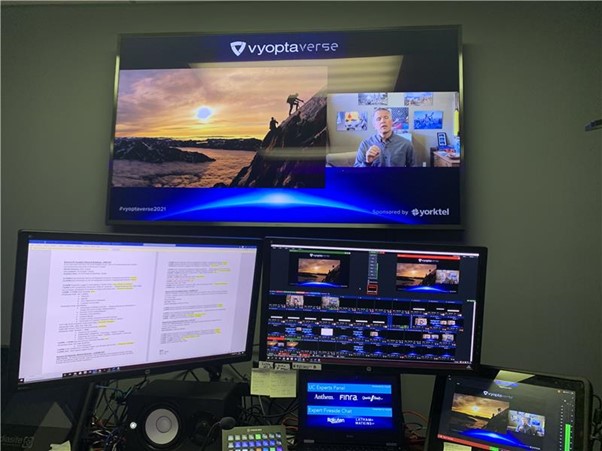In the emerging post-pandemic era, more and more businesses are choosing to engage the services of a streaming or webcasting provider to produce hybrid events for customers and employees, combining elements of physical and virtual events. While some of these hybrid events will be limited to traditional web conferencing, many companies are opting for a more produced event, giving greater reach and a much richer feature set than traditional web conferencing events can offer.
Early in 2020, the onslaught of Covid-19 took the world by surprise, sending event organizers scurrying for ways to hold events in ways that would accommodate new travel restrictions and social distancing mandates. Making quick pivots into holding virtual events, businesses discovered some unexpected advantages.
One thing about virtual events that appeals to planners is the ability to communicate with communities they’d otherwise never have connected to because of geographic barriers and travel costs. In one report looking at this initial period, EventBrite said that virtual events hosted in the US and UK on that platform during the last few months of 2020 drew over 30 percent of their attendees from other locations around the globe.
Yet while virtual events have grown in popularity for everything from industry conferences to music concerts, they’ve also proven successful for helping businesses stay in touch with remote employees and customers, but still maintaining professional standards.
More hybrid events on the way
Now, as the pandemic wanes, businesses are bringing the best aspects of live and virtual events together into the hybrid event, characterized by a mixture of physical and remote attendance.
More specifically, a study by LinkedIn of 200 businesses in the UK and Ireland discovered that 72 percent of businesses will continue to hold virtual events in the long term, while 77 percent are interested in organizing hybrid events. Their future events will be 45 percent virtual, 32 percent physical, and 23 percent hybrid.

Ensure Your Virtual Events Are Professional
Learn how you can make your virtual events as impactful as your in-person ones.
What is webcasting?
Webcasting and web conferencing are both video-enabled technologies that run over the Internet. The similarities end there, though. Web conferencing involves live interaction and conversation among multiple parties in a “meeting” setting. Typically, it’s among small groups of people. Each participant needs to be outfitted with a web camera to be seen, and a microphone to be heard.
Webcasting or live streaming, on the other hand, is the act of broadcasting or “streaming” content over the Internet, video and audio communications take place on a one-way basis only, meaning that remote visitors are not seen or heard, meaning you don’t need either a webcam or mic to take part.
Among other benefits of live streaming, streams are often recorded for availability after the live event, on an “on-demand” basis. So if you missed the live webcast of the CEO’s speech this morning, or you just want to watch it again, you can play it back at your convenience. This on-demand model then lends itself to many more uses include training, onboarding, and a much farther reach than web conferencing or a traditional full in-person option could offer.
Although much more highly scalable than web conferencing, webcasting services are sometimes described as less interactive. To put this in the context of in-person events, these are carefully managed and attendees are invited to input at appropriate times only – you wouldn’t want the hundreds of in-person attendees to be interrupting the speaker, which is perfectly replicated in a webcasting service with the correct interactive tools.
Choose a webcasting software platform that comes with interactive tools for live polling, chats, and Q&As, which aren’t included in web conferencing solutions. Sometimes these interactive features are deployed among both virtual and physical attendees. For instance, polling might be conducted among virtual attendees as well as people in the audience at the live event, giving all attendees the same event experience.
Businesses use streaming, too, for company announcements, shareholder meetings, training sessions, and virtual job fairs for prospective employees. Some streaming solutions include tools for presentations, too.
5 things to look for in a webcasting provider
Just as webcasting and web conferencing technologies differ from each other, so do the capabilities of the many streaming platforms on the market today. Here are five things to help you identify a great streaming provider:
- Experience in enterprise webcasting. While some webcasting providers are startups, others come to the task with decades of solid experience in enterprise video services. Their expertise shows in your successful event.
- Quick and easy setup of both events and application software. Prep and setup for events shouldn’t cause you stress. Application software needs to be easy, too, and it should come with default settings around security, meeting joining, and host/user PINS.
- Built-in analytics. Top platforms capture pre-event registration information for post-event analytics. Analytics can be performed on viewing durations, IP addresses, and devices used, for example.
- Integration with web conferencing tools. Streaming platforms are available which integrate with Zoom, Microsoft Teams, Cisco Webex, and Pexip so users can participate in the event from any virtual meeting room or device.
- Great scalability. Web conferencing can be a good solution for small teams. A streaming solution, though, will scale up to tens of thousands of participants.
To learn more about how to leverage streaming in your hybrid events, contact us.
